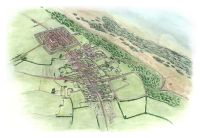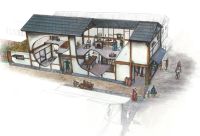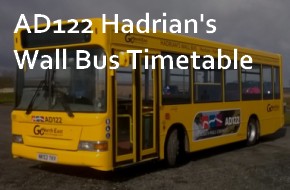Roman Maryport - Roman Settlement Project
This project is complementary to the Roman Temples Project supported since 2011 by the Senhouse Museum Trust and Newcastle University. The results of the complementary projects will contribute to the Roman Maryport programme and substantially improve our understanding not only of Maryport but of the whole Roman frontier.
 The Roman Settlement Project is led by Oxford Archaeology North’s Stephen Rowland and John Zant, and is examining part of the Roman civilian settlement just north east of the Roman fort. This year's fieldwork will take place from 7th April to 30th May 2014, and will aim to more fully excavate a selection of the remains investigated during the project's first season, last summer. These comprised the well-preserved remains of three stone buildings, a portion of the settlement's cobbled main road, and various pits and ditches within the 'backland' to the rear of the buildings. Excavation is focusing on the most complete of those buildings, and is revealing evidence for several activity phases for the internal organisation of the building, and hints about the activities hosted therein. Many of the finds recovered so far, including a small number of coins, suggest that occupation lasted from the second to the mid- to later third century AD. There are, however, tantalising glimpses of possible later activity.
The Roman Settlement Project is led by Oxford Archaeology North’s Stephen Rowland and John Zant, and is examining part of the Roman civilian settlement just north east of the Roman fort. This year's fieldwork will take place from 7th April to 30th May 2014, and will aim to more fully excavate a selection of the remains investigated during the project's first season, last summer. These comprised the well-preserved remains of three stone buildings, a portion of the settlement's cobbled main road, and various pits and ditches within the 'backland' to the rear of the buildings. Excavation is focusing on the most complete of those buildings, and is revealing evidence for several activity phases for the internal organisation of the building, and hints about the activities hosted therein. Many of the finds recovered so far, including a small number of coins, suggest that occupation lasted from the second to the mid- to later third century AD. There are, however, tantalising glimpses of possible later activity.
Extramural settlements have been relatively little studied, either in Britain or elsewhere. It is assumed they were home to a cosmopolitan mix of locals and incomers from across the Empire, including retired soldiers, serving soldiers’ dependants, and individuals who made a living from servicing the fort, from blacksmiths and food-vendors to innkeepers and prostitutes. Like frontier towns throughout history, Maryport is likely to have been a cultural ‘melting pot’, with more than its share of rogues and ‘characters’, and life would doubtless have been made all the more interesting by the presence of several hundred soldiers with money in their pockets. These men would originally have been recruited from other parts of the Roman Empire - Spain, Germany, and the eastern Adriatic, in the case of some of Maryport’s known garrisons - but the extent to which regiments recruited subsequently from the local population is not clear.
 Geophysical survey has provided exceptional evidence about the character and extent of the extramural settlement at Maryport, located to the north of the Roman fort. This settlement appears to be large, extremely complex, and exceptionally well-preserved. The geophysics results indicate that the heart of the extramural settlement comprised linear building plots on either side of the main street running northwards from the north gate of the fort. The project focuses on excavating as much as possible of a single house plot from the frontage on the main street to the 'backlands' at the rear of the plot.
Geophysical survey has provided exceptional evidence about the character and extent of the extramural settlement at Maryport, located to the north of the Roman fort. This settlement appears to be large, extremely complex, and exceptionally well-preserved. The geophysics results indicate that the heart of the extramural settlement comprised linear building plots on either side of the main street running northwards from the north gate of the fort. The project focuses on excavating as much as possible of a single house plot from the frontage on the main street to the 'backlands' at the rear of the plot.
The project has ‘ground truthed’ elements of the geophysical survey, and is seeking to establish the nature of the civilian occupation and its history within a defined portion of the settlement. This work is of international significance, not only for the study of Hadrian’s Wall and its associated coastal defences, but for Roman frontiers generally, and the nature of the Roman world at its boundaries, as well as contributing to the ongoing debate on the nature and extent of ‘Romanisation’ in the provinces.
Volunteer Excavators
Volunteers are welcomed, as you will form the mainstay of the project: this is a genuine research excavation, and your efforts will make a major contribution to furthering understanding of one of the most important Roman sites in Britain. It doesn’t matter if you have little, or indeed, no, experience, because our team of professional supervisors will provide you with all the training and direction you need. Nonetheless, a certain sense of fortitude, and a willingness to learn, will come in handy! You will be working outdoors and the weather on the Cumbrian coast is variable – when the sun shines, though, the views across to Scotland, the Isle of Man and even Ireland are spectacular! The dig is open to everybody over nine years old (if you are between 9 and 16 years old you will need to be accompanied by a parent/guardian), but please be aware that the site is in a field and that disabled access may not be particularly easy in, or following, poor weather.
Programme
The dig will run five days a week (including Bank Holidays), for eight weeks, and we can accommodate up to 15 volunteers at any one time. Within certain parameters, you can volunteer for as long as you like, even for the full duration of the project, as long as we can provide as many people as possible with a chance to join in. The minimum period is one whole day, although we would encourage people to come for at least five days in order to learn a range of skills and to gain as much as possible from the experience. However long you can come for, we will do our best to accommodate you. There will be open days on Saturday 19th April and Bank Holiday Mondays 5th May and 26th May when you would be able to visit the site, and, if you can book in advance, experience a practical session. As ever, book early to avoid disappointment!
Activities and Training
We wish to offer you as complete an experience of the archaeological process as you want to be involved with: if you let us know what you’re interested in, we will try to ensure you get an opportunity to do it. We would hope to engage you in the various techniques used when excavating a range of features and deposits, the methods of recording (written, drawings and photography) and surveying, as well as the different means of recovering finds and collecting samples for environmental analysis. At each stage we will explain why we do things a certain way, and how each element fits into the wider understanding of the site.
As well as excavating, there will be an opportunity to work with the on-site metal detectorists, to process, catalogue and draw, the finds, and to process, sort, and record material from the environmental samples. In addition, it is hoped that you will be able to put the records you make onto the database, and digitise your site drawings if you so choose.
Our resident experts in various finds, plant remains, animal bones, and human remains will also come to site to deliver specialist demonstrations and training.
What you will need
We will provide you with all the tools and equipment you will need, although if you already have a favourite trowel, please feel free to bring it with you. However, we can’t clothe you (!). You will need stout shoes, and you should also consider some form of gardening gloves and a kneeling pad. The weather at Maryport can be variable, so have several layers of clothing and bring waterproofs, a hat, and suncream. It is recommended that all participants should have an up to date tetanus jab.
Applications
If you would like to volunteer, please download and complete an application form here, then email it to [email protected]
As part of you induction pack we’ll send you information on places to stay, how to get to site, where to park, and health and safety information.
Visitors
The site will be open five days per week from 7th April to 30th May so that visitors can see the excavations in progress and receive a talk on the project from the on-site archaeologists. In addition, there are open days on Saturday 19th April, Monday 5th May, and Monday 26th May. There is no age restriction for visitors, but those under the age of 16 should be accompanied by a parent or guardian. Access to the site will be in the form of guided tours from the Senhouse Museum. There is parking at the museum, or, alternatively, at Camp Farm and on Camp Road. There will be two tours each day in the afternoon at 2:00pm and 3:30pm. There is no need to book but check the times on the website before you come. Additional tours may be arranged in the mornings and in the evenings at weekends - check the website and at the Senhouse Museum for the latest information. During museum opening hours there is a charge of £3.00 per adult and £1.00 per child (£8.00 for families) which includes access to the Senhouse Museum.
Please be aware the site is within a field and that disabled access may not be particularly easy in, or following, poor weather. Stout shoes and weather-appropriate clothing is recommended.
School Parties
We are very keen for school groups to visit, and become involved with, the excavation. We aim to offer an experience that is both entertaining and educational, whatever the weather. Our Community Archaeologist (a former Headmaster!) is happy to work with teachers to tailor the visit to your particular needs, the age of your pupils, and the requirements of the curriculum. As a suggestion we recommend each visit would last about half a day, and would involve three main components:
- An introductory session at the Senhouse Museum (which will be the meeting point for the visit);
- A visit to the site, including meeting the archaeologists, their tools and techniques, and, in small groups, undertaking a range of practical tasks (weather permitting) such as some small-scale excavation tasks (e.g. trowelling upper layers of soil), sieving for finds, washing finds, examining and learning about finds, drawing finds, and reconstructing pottery vessels;
- A creative activity back at the Senhouse Museum such as helping make a Roman mosaic.
We would aim to provide you with suitable information (such as leaflets, powerpoint presentations) both before and after your visit, in order to place your visit in context and to keep you up to date with the progress of the excavation: we’d be very happy for you to come back and see us again in 2014.
Please bear in mind that, although our CRB-checked Community Archaeologist would always be on hand and will actively engage with the school parties, these visits are likely to be most successful where you can bring sufficient teachers/classroom assistants/guardians to be able to divide the groups into bunches of about six pupils.
What to wear: pupils and teachers should wear stout shoes and weather-appropriate clothing. It is worth considering that archaeology is dirty business, and neither teachers nor pupils may return home in the same pristine state that they arrived in. It is recommended that all participants should have an up to date tetanus jab.
Registering you Interest
Please email [email protected] directly to register your interest and, if necessary, arrange a telephone call to discuss specific details.
Young Archaeologist’s Clubs
We are very happy for Young Archaeologists Clubs to get involved with the project, and can offer you a range of practical tasks (weather permitting) such as small-scale excavation (ie trowelling top/subsoil), sieving for finds, processing, examining, drawing and learning about finds, and palaeoenvironmental sample residues. Although we can provide the tasks and instruction, it is expected that YAC members would participate under the direct supervision of their leaders at an appropriate ratio.
Attendees will need stout shoes, and should also consider some form of gardening gloves and a kneeling pad. The weather at Maryport can be variable, so wear layers and bring waterproofs, a hat, and suncream. It is recommended that all participants should have an up to date tetanus jab.
Registering your Interest
Please email [email protected] directly to register your interest and, if necessary, arrange a telephone call to discuss specific details.


.gif)


 button to add an item to your Itinerary basket.
button to add an item to your Itinerary basket.
